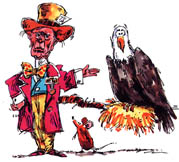|
|
|
BABBITT IN WONDERLAND
Claims by Bruce "the mad hatter" Babbitt get curiouser and curiouser.
© 1998 By Congressman Richard Pombo. Illustration by John Bardwell. |
 |
For a copy of the current issue
call 1-800-RANGE-4-U.
|
With apologies to Lewis Carroll, author of "Alice in Wonderland,"
I will now lead you through a modern day fairy tale about the
Endangered Species Act (ESA). It begins like this:
"Babbitt announces new policy, plans to 'delist' endangered species,"
proclaimed a Department of Interior press release on May 6, 1998.
"In the near future, many species will be flying, splashing and
leaping off the list. They made it. They are graduating. They're
coming back to their native American soil, water and wind," claimed
Bruce 'The Mad Hatter' Babbitt.
Tell that to the Mariana mallard, one of the "success stories"
proposed for delisting. It will not be flying, splashing or leaping
any time soon. That's because it is extinct! Ditto for the Guam
broadbill and three species of the Oahu tree snail. They have
all successfully "graduated" off the endangered species list,
and into extinction!
And the ESA fairy tale only gets "curiouser and curiouser!"
as Alice would say as she wandered through Wonderland.
Many other species proposed for removal from the list are not
success stories either. Several such as the Truckee barberry are
being delisted as a result of taxonomic error. This means that
it was initially identified as a unique species, different than
any other plant, when actually it is not unique and should have
not been listed in the first place. The U.S. Fish & Wildlife Service
(FWS), a division of Interior, has acknowledged this, and agreed
to propose delisting.
There are several more so-called successes proposed for removal
because of data error, such as the Dismal Swamp shrew. This species
was severely undercounted when it was listed, and is actually
much more plentiful than previously thought. FWS is proposing
several delistings on this basis as well.
The Peregrine falcon's recovery was initially hindered by bureaucratic
bungling at FWS. In its Aug. 25, 1998 announcement delisting the
falcon, the service heaped praise on itself, claiming that its
"recovery program is unprecedented in the world and in the history
of endangered species conservation." This is a farce.
After elimination of the pesticide DDT in 1972, the falcon's
situation improved. Recovery was enhanced by breeding while in
captivity, and then controlled release of birds into the wild.
Captive breeding is discouraged under the ESA, and for several
years FWS discredited this method of saving the falcon. Congress
finally stepped in and demanded that FWS cooperate with the private
sector foundations that deserve the credit for recovering the
falcon.
The bald eagle, our national symbol, is another example of
claiming credit where none is due. Once nearly extinct, the eagle
has recovered dramatically since the elimination of DDT in 1972,
and prohibitions were placed on hunting. In addition, legislation
specific to the bald eagle already protects it regardless of the
ESA.
The May 6 "success story" announcement was held near a bald
eagle nesting site in western Massachusetts. It claimed to show
how government enforcement of the ESA is saving our national symbol.
Actually, it served as a prime example of non-ESA factors leading
to recovery of a species. The nest location is NOT an FWS wildlife
refuge or a government-owned wilderness. It is on private property
owned by a utility company, adjacent to a privately operated campground
and canoe rental recreation area!
Overall, of the 34 species the Mad Hatter claimed as "proof
that the act works," five are extinct, 12 listings were based
on inaccurate information, and three other species recovered because
of the ban on DDT. The rest improved because of actions initiated
before the ESA was law or because of actions taken independently
of the ESA by state and local government, private property owners
and private foundations, for example.
The Mad Hatter's henchmen have not responded well to this distressing
news. Like Wonderland's Queen of Hearts, they have shouted "Off
with their heads!" to anyone questioning their version of events.
"It's their own spin," says one henchman, while another points
a finger within the department and claims "a biologist error."
This is apparently how scientific peer review and sound science
work at Interior. When press flacks make a mistake, blame it on
the biologists!
I appreciate the department cleaning up the endangered and
threatened species list. It is understandable that after 25 years
and 1,138 listed species, there will be a few mistakes made. Species
will be removed from the list for reasons other than recovery,
such as the Truckee barberry. They will also recover from factors
not related to the ESA, such as the bald eagle. However failures
should not be claimed as successes. Secretary Babbitt is struggling
to find even one species that has been legitimately saved by the
ESA.
Secretary Babbitt claimed that, "We can now finally prove one
thing conclusively: The Endangered Species Act works! Period."
Yet the best he can come up with is a list of extinctions, mistakes,
exaggerations and false claims. Perhaps the Eaglet in Wonderland
said it best when he told the Dodo bird, "Speak English! I don't
know the meaning of half of those long words, and, what's more,
I don't believe you either!"
|